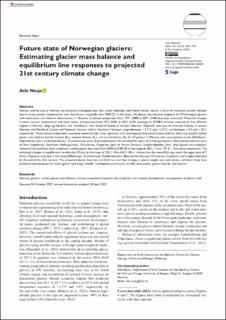| dc.description.abstract | Glaciers and ice caps in Norway are presently undergoing mass loss, areal reduction, and frontal retreat, mainly a result of increased summer ablation due to rising summer temperatures over Scandinavia, especially after 2000 CE. In this paper, the glacier mass-balance response of 10 Norwegian glaciers with continuous mass balance observations (>10 years) to climate projections from 1971–2000 to 2071–2100 have been estimated. Projected changes in mean summer temperature and mean winter precipitation from 1971–2000 to 2071–2100, applying the RCP8.5 emission scenario for five different regions in Norway; ‘Sogn og Fjordane’ and ‘Hordaland’, now Vestland County in western Norway, ‘Oppland’, now part of Innlandet County in eastern Norway, and Nordland County and Finnmark County, both in Northern Norway), range between +3.5°C and +5.0°C, and between +5% and +25%, respectively. These climate projections have been converted (by linear regression with overlapping observational mass-balance data) into specific surface glacier mass balance [winter balance (Bw), summer balance (Bs), and annual balance (Ba) for 10 glaciers in Norway with mass-balance series [Ålfotbreen, Nigardsbreen (part of Jostedalsbreen), Austdalsbreen (part of Jostedalsbreen), Rembesdalskåka (part of Hardangerjøkulen), Blomstølskardsbreen (part of Søre Folgefonna), Storbrean, Hellstugubrean, Gråsubrean, Engabreen (part of Vestre Svartisen, Langfjordjøkelen (data: http://glacier.nve.no/glacier/viewer/ci/no/) yielding a total, cumulative surface glacier mass loss from 2000 to 2100 CE in the range of -85.2 ± 4 to -197.3 ± 10 m water equivalents. The estimated changes in equilibrium-line altitudes (ELAs), in the range of 230 ± 10 to 630 ± 30 m, indicate that the mean ELA may reach the upper part of 7 of the 10 glaciers included in this study [Ålfotbreen, Austdalsbreen, Rembesdalskåka, Blomstølskardsbreen, Gråsubrean, Engabreen and Langfjordjøkelen] by the end of the 21st century. The projected glacier mass loss and ELA rise, and thus changes in glacier length, area and volume, will most likely have profound consequences for future glacier hydrology (runoff), hydropower production, wildlife, ecosystems, glacier hazards, and tourism. | en_US |

